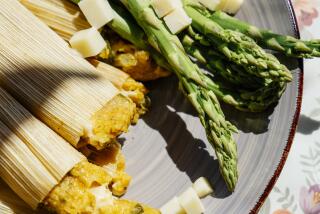Pushing ‘The Other Red Meat’
- Share via
MONTROSE, Colo. — At 54, rancher Bob Hasse has always been a meat-and-potatoes kind of guy. For the last few years, the meat has been yak.
Three or four times a week, Hasse and his family break bread over prime cuts from the Tibetan beast of burden. They eat it for lunch and dinner. They use it in spaghetti sauce. They grind it up and pop it on hamburger buns. Hasse loves to grill a good yak filet mignon, topping it with a dollop of bearnaise sauce or a light apricot glaze that enhances the meat’s natural yakiness.
“Yak has a more delicate taste than beef,” Hasse said as he tended a couple of yak steaks over his backyard barbecue. “It’s sweeter. It’s less greasy. I don’t know if I could ever go back to beef.”
Hasse, who left battery manufacturing to become a rancher, wants nothing more than for lots of other people to crave a nice piece of low-cholesterol, high-protein yak. As president of the International Yak Assn., he is one of a couple of dozen ranchers who dream of making yak “The Other Red Meat” -- a feat characterized as practically impossible by some marketing experts.
“I think it’s hopeless,” said David Pursglove, a Washington, D.C., consultant who analyzes food trends for major corporations. Buffalo and ostrich didn’t fill the nation’s plates as their promoters had hoped, he said, and neither will yak.
“People don’t go to restaurants to experiment. They go to have a good time,” said Pursglove, who predicts that white tea -- but not yak -- will be the hot new thing among trendsetters in the next three years.
But casting your lot with that of the yak takes a certain kind of optimism in the first place. Hasse points to yak popping up on menus in upscale restaurants scattered around the West. Last year, the Saddle Peak Lodge in Calabasas showcased yak on a $65 four-course “tasting menu.”
“People loved it,” said executive chef Warren Schwartz. “Yak is a wonderful meat. But you have to do a little playing around with the name; we called it ‘Himalayan beef.’ ”
Jerry McRoberts is the nation’s biggest yak breeder. With more than 1,000 of the animals, which resemble shaggy cows, roaming his pastures in the western Nebraska hills, he controls half the nation’s yak reserves. He also breeds yak and cattle to create the “half-yak,” which bulks up a lot quicker than pure yak. Distributors buy his meat in bulk, including items such as the astonishingly cross-cultural yak bratwurst.
“Yak is a wonderful, healthy, delicious meat,” McRoberts said. “But there’s something about the name that just turns people off. I don’t know why.”
At Denver’s venerable Buckhorn Exchange, where trophy heads cover the walls and appetizers include marinated rattlesnake, yak is simply yak and no one seems to mind.
“We put it in as a Father’s Day special two years ago, almost as a publicity stunt,” said general manager Bill Dutton. “The promotion was something like ‘Yak it up with Dad.’ ”
Unexpectedly, customers liked the steaks so much that yak became something of a Buckhorn fixture, depending on the supply, Dutton said. Now, it’s a big seller, with about 1,200 customers a month venturing into the culinary territory of the Sherpas. Whether they’ll be followed by Americans more attuned to Taco Bell than temple bells is an open question.
Ranchers like Hasse are all too familiar with the inflated claims that promoters of the ostrich made in the last two decades. Prices for the bird soared, but not demand for its meat.
“What are they worth now?” Hasse asked. “They’re setting them loose on the highways.”
Breeders of buffalo also have had their problems.
“They’re doing better now, but for a while they got caught up in the hysteria of getting $60,000 for a grand champion,” said Rick Van Zant, an owner of House of Smoke, a distributor of exotic meats based in Fort Lupton, Colo.
So far, Hasse said, there has been no yak bubble to burst. There aren’t enough yak to consistently give chefs in places like Aspen the fresh meat they want.
The market is still tiny. In the U.S., almost no research has been done on the commercial possibilities of yak. Only 2,000 yaks are raised on farms and ranches in the U.S., while 250,000 bison are at home on the range.
“We’re doing some pioneering here,” Hasse said.
Hasse bought his first yaks in 1998.
“I wanted an idiot-proof animal,” he said. “I wanted something that could take care of itself without us being around it.”
Most of his 100 animals graze on 800 acres he owns an hour from the nearest paved road and three hours from his home.
In a pasture across from his Montrose home, Hasse admires the two dozen yaks yet to be trucked to the high country. They’re brown, black, white and dappled. Males and females sport horns. They grunt like pigs but never bellow. Except for critters like Buddy, a premature yak that he bottle-fed, they have no use for humans.
“They’re very intelligent,” Hasse said. “They remember faces. If you treat them well, they’ll remember.”
Hasse is a true believer when it comes to yak meat’s health benefits. Yak has less cholesterol and saturated fat than beef, Hasse said, plus the omega oils found in fish.
“But we don’t have the mercury,” Hasse adds.
Or, so far, the distribution.
Tsering Wangmo, owner of a Tibetan restaurant in San Francisco called Lhasa Moon, said many customers who have traveled to Tibet ask for yak. She’d like it too; a Tibetan refugee born in India, she never has had so much as a yak hors d’oeuvre.
“We can’t get the meat,” said Wangmo. “I tell them the cow is a kind of stand-in for the yak.”
More to Read
Sign up for The Wild
We’ll help you find the best places to hike, bike and run, as well as the perfect silent spots for meditation and yoga.
You may occasionally receive promotional content from the Los Angeles Times.







